How to Prevent Overselling

As a retailer in the 21st century, you have many options for getting your products into the hands of customers. You might have brick-and-mortar locations and an online store, and you might sell through marketplaces such as eBay, Amazon or Etsy. All the options available mean that you can easily expand your customer base and reach people you wouldn’t connect with otherwise.
Selling in multiple locations can also increase the risk of overselling, or making more sales than the actual number of items you have in stock. For example, if you might be down to your last in-stock widget. Customer A purchases the widget directly from your online store while Customer B purchases it from your Amazon shop. One of those customers is going to have to receive a “we’re sorry, but the item you ordered is no longer available” email.
It’s in your best interest to avoid and control overselling as much as possible. When you sell items that you don’t actually have available, it can lead to dissatisfied customers. Overselling also puts more of a burden on your business, as you need to do damage control and also track down the source of the problem.

Take a closer look at why overselling happens, why you want to prevent it and what you can do to avoid overselling.
Why Does Overselling Happen?
Overselling happens when a company sells more items than it actually has available. Overselling can be accidental or intentional. Airlines, for example, were once notorious for overselling seats on planes. At one point, more than 40,000 people per year had to be removed involuntarily from the seats that they purchased a ticket for. The airlines had their reasons for overselling tickets. People occasionally end up canceling their trips at the last minute. If the person who cancels purchased a refundable ticket, the airline would potentially miss out on that revenue. But if they sold two tickets for the same seat, then the hope was that someone else would fly and help the airline avoid missing revenue.
In other cases, overselling isn’t something that a company does intentionally. A product can be oversold because of a miscount. For example, inventory records might state that there are 11 of one item available when really there are only 10. If 11 people purchase the item, there won’t be any left when it’s time to fulfill the 11th shopper’s order.
Another reason items can oversell is if inventory records don’t sync quickly enough. In some cases, inventory for different locations or different online outlets doesn’t sync up until the end of the day. If all of the inventory is counted together, that can mean that you sell more of the item than is available. If people place orders overnight, there is a chance that the inventory won’t reconcile in the morning.
Sometimes, overselling happens due to forces that are beyond your company’s control. If you use drop-shipping, the business that sends out the item might run out before it receives your order. It might also be the case that the manufacturer or wholesaler who typically provides you with inventory runs into unforeseen issues, causing a delay in its shipment to you.
Why You Want to Stop Overselling Inventory
Only selling items you have available to ship or give to customers is in your company’s best interests for several reasons. Here’s why your company should make every effort to stop overselling inventory:
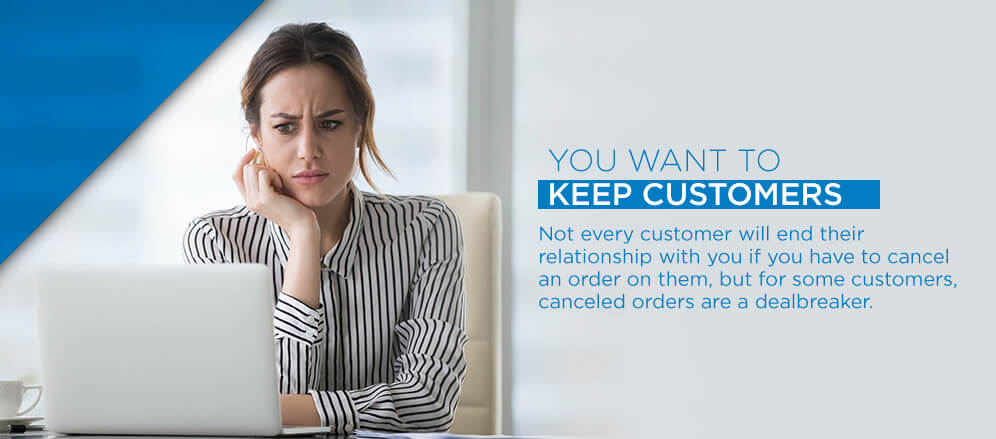
You Want to Keep Customers
Not every customer will end their relationship with you if you have to cancel an order on them, but for some customers, canceled orders are a dealbreaker. They might stop buying from your business entirely after an order gets canceled. Even if a customer returns to your company for a future purchase, you’ve lost their sale and business for the time being. If you can’t sell them what they want to buy, they’ll go somewhere else to find it.
You might think it’s not a big deal — there are always more customers out there. But consider this: Getting a new customer can cost your company up to 25 times more than retaining an existing customer. It takes significantly more effort and time to get a new customer on board with your company than it does to convince an existing customer to make another purchase. Additionally, existing customers are more likely to purchase more when they buy from you again.
Finding ways to better manage your inventory will help you keep customers, increasing your business’ sales.
You Want to Maintain Your Reputation
Regularly overselling items can make people think twice about buying from you again. Even if you have items in stock in the future, you might end up with a reputation for always being sold out of the things people want to buy. That can mean that your existing customers don’t come back and warn others away from purchasing from your company. A Nielsen survey of people in 60 countries found that 83% of respondents put the greatest amount of trust in the recommendations they get from family and friends, so if people are telling others to steer clear, it can affect your bottom line.
If your customers are happy and are saying great things about your business to others, you’re likely to see an uptick in sales. But if you’ve upset customers by overselling, you are likely to see sales stagnate or even drop.

You Want to Stay Competitive
Overselling can be a bit like kicking the ball into your own goal during a soccer game or tossing the ball through the other team’s hoop in basketball. When you sell more than you have available and send customers out-of-stock notices, you effectively push them to your competitors. Helping the competition isn’t exactly the best way to stay in business or to continue to build your revenue.
It’s imperative that you have enough inventory on hand to meet the needs and expectations of your customers. Regularly overselling means you’re helping out the competition in a way that you most likely don’t want to do.
Put yourself in the shoes of your customer: Would you rather purchase from a company that has items available and that ships them quickly or from a business that frequently sends out-of-stock notices or has items on backorder? In a world where two-day shipping has started to seem slow, people are less willing to wait for products and more likely to be disappointed when they do get a sell-out notice. Your business can stay competitive by always having items available and by shipping those items to customers right away.
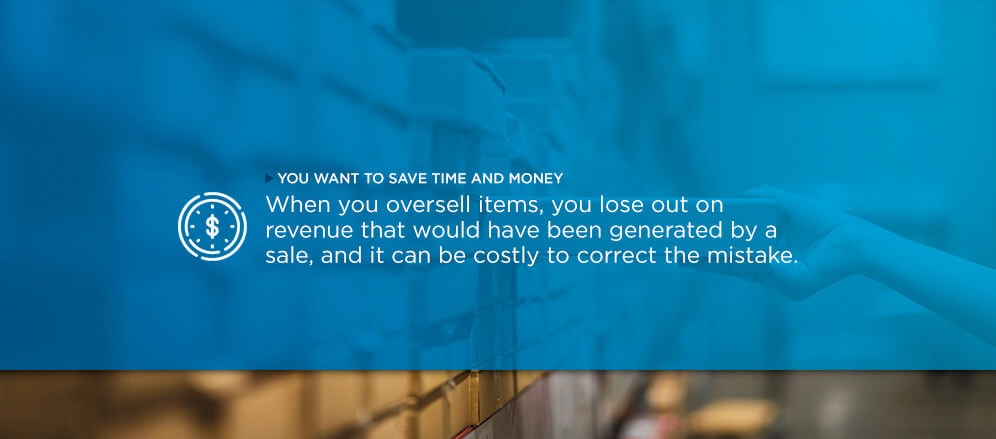
You Want to Save Time and Money
When you oversell items, you lose out on revenue that would have been generated by a sale, and it can be costly to correct the mistake. Once the problem is discovered, someone from your team needs to take the time to send out the out-of-stock notices and to make adjustments to the customer’s order, including refunding their money. That’s likely time your team members could have spent more productively.
Someone then has to go in and reconcile the inventory, making sure that the numbers match what is actually available. If the item is popular, you’ll need to calculate how much of the item to reorder and then have someone from your team place the new order.
Preventing overselling can have a positive effect on your company’s bottom line as it ensures that customers get what they ordered and reduces the need to have your employees dedicate some of their working hours to damage control. When you don’t oversell, your team can focus on doing more productive things.
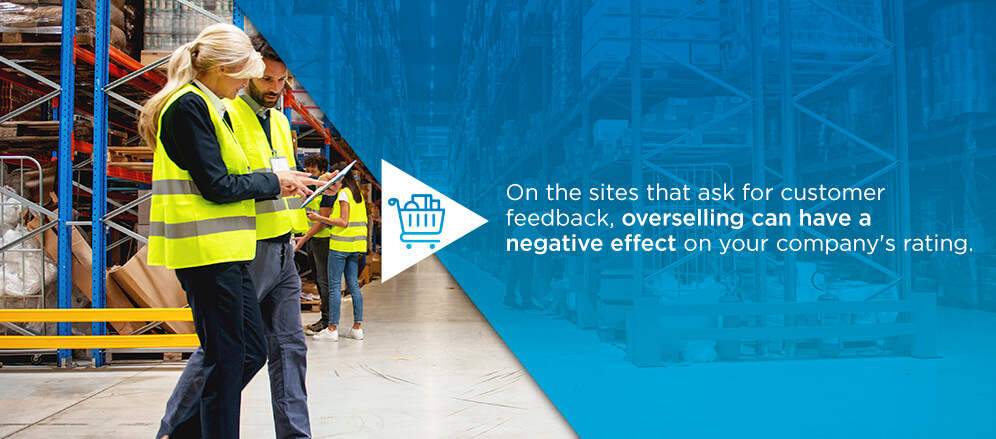
You Want to Avoid Getting Penalized by a Selling Platform
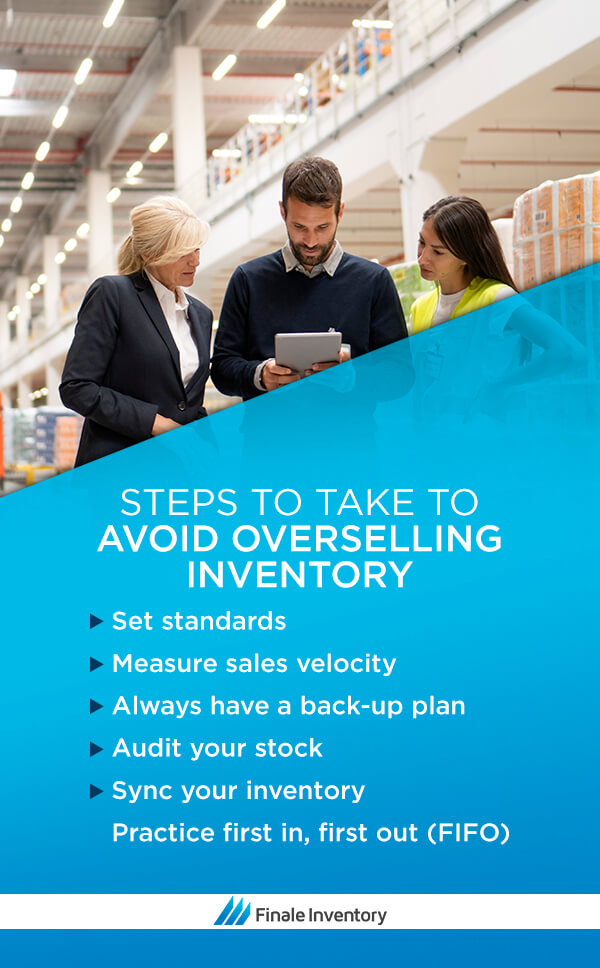
If you sell on a third-party platform, there can be serious consequences to overselling. Most selling platforms expect your listings to be accurate. If they are not, customers might report you to the platform. Depending on how often the overselling or out-of-stock notices happen, you could risk getting kicked off of the platform.
On the sites that ask for customer feedback, overselling can have a negative effect on your company’s rating. Customers might be wary of buying from a store that has a three-star rating when they can easily find a business with a five-star rating that sells the same items.
Steps to Take to Avoid Overselling Inventory
Getting a good handle on your company’s inventory is the key to avoiding overselling. Here are our best tips to prevent overselling and get your inventory under control:
- Set standards: When should you place an order for more of an item? To avoid overselling or stock-outs, it’s best to order more when your inventory reaches a certain level. The standard level is the minimum number of a certain item that you want to have on-hand. For example, if you sell widgets, you might set the standard level to three. When only three widgets remain, it’s time to reorder. Standard levels will vary based on several factors, including how long it takes a manufacturer or wholesaler to ship an item to you and how popular an item is.
- Measure sales velocity: How do you know how quickly particular items sell? You need to track the sales velocity of those items. Sales velocity is the rate at which an item sells during a period, such as during one month or one quarter. To calculate it, you take the number of a particular product sold during a period, then divide that by the number of days to see how many sold each day. For example, if you sell 90 units of an item during a 30-day period, the sales velocity is three units per day. Some items sell quickly at all times of the year, others see an uptick in sales velocity during certain seasons and others are slow-sellers year-round. Finale Inventory lets you use sales velocity to help you determine when the best time is to place a new order.
- Always have a back-up plan: Sometimes things don’t go as planned. Your suppliers might run into difficulty getting a particular product to you or an unexpected change might lead to an increase in demand for a particular product. It’s a smart move to always have some sort of back-up plan so that you can avoid overselling or selling out. For example, you might keep a back-up supply of a particular product on hand, so that you have some to sell if there’s a delay from the supplier or a sudden jump in demand. Another option is to have a relationship with a drop-shipping company that can send out items when your on-hand stock is low.
- Audit your stock: From time to time, check to confirm that your inventory numbers align with what you actually have on hand. Using an inventory management software program isn’t a fool-proof overselling prevention method. Inaccuracies can still occur, whether they are due to shrinkage, such as shoplifting or employee theft, or simple human error. For example, a picker might accidentally pull two of the same item off of the shelf to send to a customer but only record one item as being shipped. Do a physical count of your inventory every season or so and reconcile the numbers if necessary.
- Sync your inventory: If you sell on multiple platforms, when a sale takes place on one platform, inventory levels should adjust on the other platforms right away, especially if you combine your inventory rather than separate it out based on location. When inventory doesn’t sync immediately, you risk overselling, especially if your stock levels are close to your standard level. Inventory management software should sync stock levels across platforms as soon as a sale happens to reduce the chance of selling more than is available.
- Practice first in, first out (FIFO): FIFO is particularly important if you sell items that have a shelf-life, such as food or cosmetic products. You don’t want to think that you have ample stock on hand, only to find out that it’s all past its sell-by date and can’t be sold. Even if you aren’t selling perishable items, it’s still a good idea to practice FIFO. A customer who receives a product in packaging that’s outdated might wonder how long it’s been sitting in the warehouse. FIFO can also help you see if certain items sell quickly or if they languish on the shelves of your warehouse.
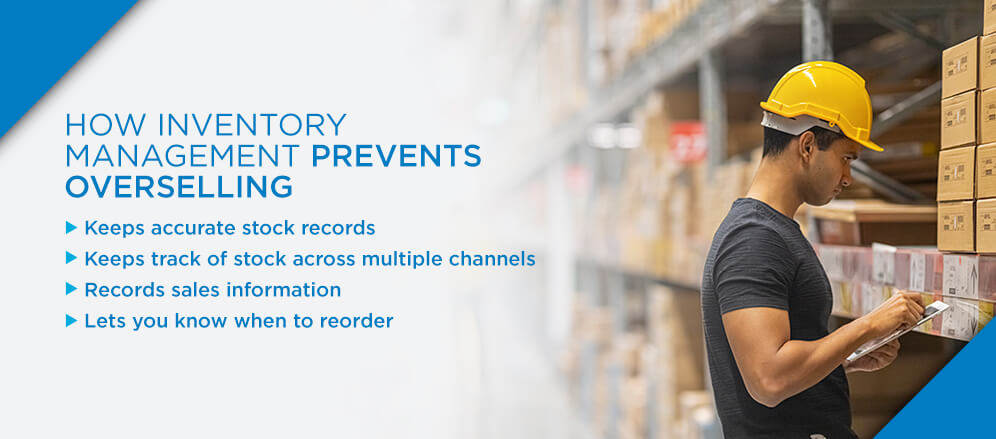
How Inventory Management Prevents Overselling
Keeping track of your inventory helps you avoid selling more than you have available. You don’t have to manage your inventory by hand or rely on paper and pen to track stock levels. An inventory management system can automate the process, adjusting stock levels as items sell and making sure that stock records are accurately adjusted across all platforms. Along with keeping you up-to-date on stock levels, inventory management software can also automate the reordering process and help you determine what sells best where. Some of the ways inventory management prevents overselling include:
- Keeps accurate stock records: When you use inventory management software, such as Finale Inventory, you get access to accurate, real-time stock records. You can use the software to confirm that you have X number of a particular item on a shelf in a warehouse. Since the system is automated and updates itself as items are sold, it’s much more accurate than counting your stock by hand or using a system of tally marks or cross-offs to track inventory.
- Keeps track of stock across multiple channels: If you sell on multiple platforms, you have two options for tracking inventory. You can portion everything out, allowing X number of items to Amazon, X number to eBay and X number to your online store. But what happens if your store becomes more popular than your other platforms or there’s more demand for your products on Amazon or eBay? Your product will appear to be sold out on the platforms where it is most popular. Meanwhile, you have plenty of actual stock on hand. Inventory management often allows you to track stock levels across multiple channels. That way, if one channel becomes more popular than the others, it will still be possible to sell on it, provided you have the item available.
- Records sales information: Inventory management goes beyond keeping track of how much you have on-hand. It also involves keeping track of sales information so you can accurately predict when the best time is to place a new order. Past sales information also helps you see when an item sells best or when it doesn’t. You can also use the data to see if an item is no longer popular and isn’t worth keeping in stock or reordering in the future.
- Lets you know when to reorder: Inventory management takes the guesswork out of reordering. You can set up the software to automatically reorder once inventory levels reach a certain threshold. Inventory management also helps you forecast your stock needs. For example, if the holiday season is coming up and your past sales data show that you typically sell more a certain product during that time, you can order extra in anticipation of increased demand.
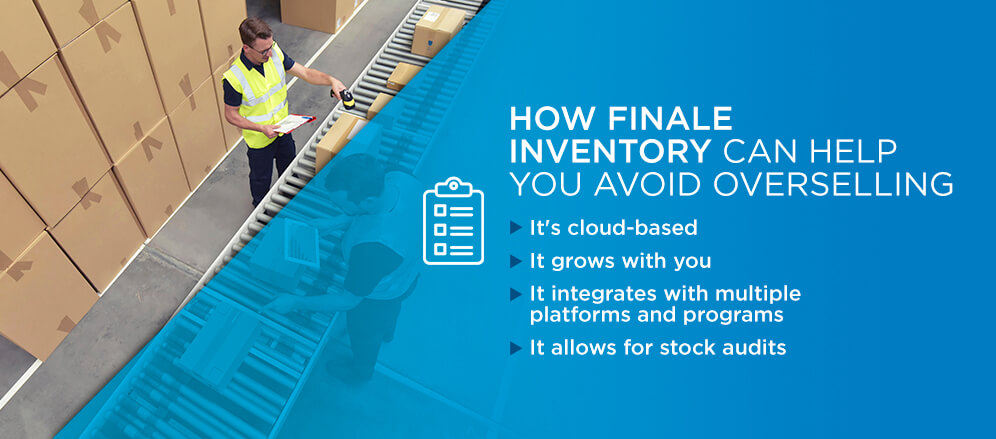
How Finale Inventory Can Help You Avoid Overselling
Not all inventory management platforms are the same. Finale Inventory offers multiple benefits and features that can help your business avoid overselling and that can increase your efficiency.
- It’s cloud-based: Finale Inventory is a cloud-based inventory management system, which means that all of the information is stored in an online, secure database. You and your team members can access the information stored in the database from any device that connects to the internet. The cloud-based system also updates itself in real-time, so there’s no waiting for reports to reconcile or inventory to adjust. Real-time updates help you avoid overselling products.
- It grows with you: As your business grows and begins to sell on additional platforms or increases inventory, Finale Inventory grows with you. Since it is cloud-based, there is no need to update hardware or buy new equipment as your business scale upward. The platform lets you add on new platforms as needed so that everything remains in sync.
- It integrates with multiple platforms and programs: Finale Inventory integrates seamlessly with various marketplaces, point-of-sale systems, accounting software and shipping services. The marketplace integrations can be particularly useful to companies interested in minimizing or preventing overselling.
- It allows for stock audits: You can use Finale Inventory to help you through the stock auditing process. The software shows you who was responsible for what when it comes to a particular stock item. For example, you can see who received the order of an item and who picked it off of the shelves. You get clarity about who in your company did what, which can help you account for any discrepancies between reported stock and actual stock on hand.
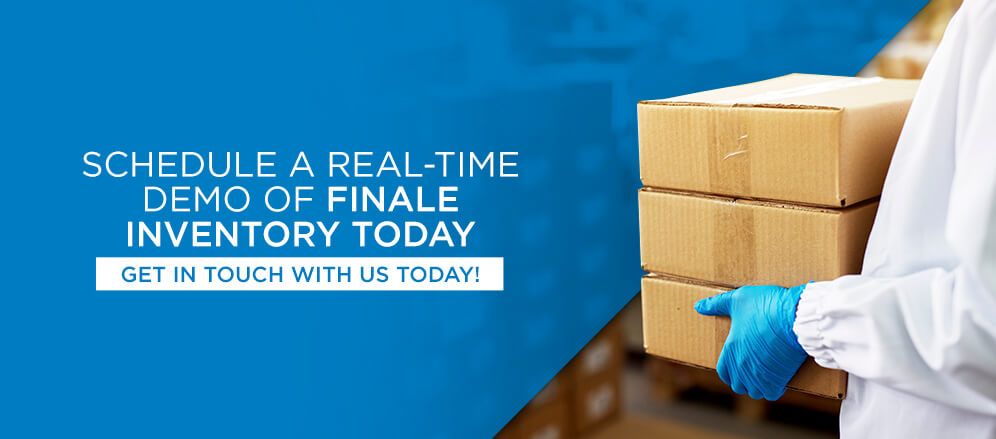
Schedule a Real-Time Demo of Finale Inventory Today
Overselling can negatively affect your relationship with customers and lead to lost sales and revenue. Luckily, there are ways to avoid it. Finale Inventory helps you avoid overselling by centralizing your inventory tracking system and by providing you with forecasting tools and automated reordering. See how it works for yourself: Schedule a demo today.





